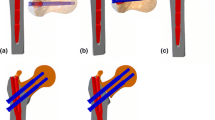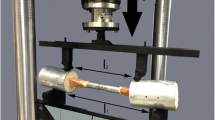Abstract
Purpose
Due to increasing life expectancy we see a rising number of joint replacements. Along with the proximal prosthesis in the femur, more and more people have a second implant on the distal ipsilateral side. This might be a retrograde nail or a locking plate to treat distal femur fractures or a constrained knee prosthesis in the case of severe arthrosis. All these constructs can lead to fractures between the implants. The goal of this study was to evaluate the risk of stress risers for interprosthetic fractures of the femur.
Methods
Thirty human cadaveric femurs were divided into five groups: (1) femurs with a prosthesis on the proximal side only, (2) hip prosthesis on the proximal end and a distal femur nail, (3) femurs with both a hip prosthesis and a constrained knee prosthesis, (4) femurs with a hip prosthesis on the proximal side and a 4.5-mm distal femur locking plate; the locking plate was 230 mm in length, with ten holes in the shaft, and (5) femurs with a proximal hip prosthesis and a 4.5-mm distal femur locking plate; the locking plate was 342 mm in length, with 16 holes in the shaft.
Results
Femurs with a hip prosthesis and knee prosthesis showed significantly higher required fracture force compared to femurs with a hip prosthesis and a distal retrograde nail. Femurs with a distal locking plate of either length showed a higher required fracture force than those with the retrograde nail.
Conclusions
The highest risk for a fracture in the femur with an existing hip prosthesis comes with a retrograde nail. A distal locking plate for the treatment of supracondylar fractures leads to a higher required fracture force. The implantation of a constrained knee prosthesis that is not loosened on the ipsilateral side does not increase the risk for a fracture.




Similar content being viewed by others
References
Appleton P, Moran M, Houshian S, Robinson CM (2006) Distal femoral fractures treated by hinged total knee replacement in elderly patients. J Bone Joint Surg Br 88:1065–1070
Fink B, Fuerst M, Singer J (2005) Periprosthetic fractures of the femur associated with hip arthroplasty. Arch Orthop Trauma Surg 125:433–442
Hou Z, Moore B, Bowen TR, Irgit K, Matzko ME, Strohecker KA, Smith WR (2011) Treatment of interprosthetic fractures of the femur. J Trauma 71:1715–1719
Iesaka K, Kummer FJ, Di Cesare PE (2005) Stress risers between two ipsilateral intramedullary stems: a finite-element and biomechanical analysis. J Arthroplasty 20:386–391
Kenny P, Rice J, Quinlan W (1998) Interprosthetic fracture of the femoral shaft. J Arthroplasty 13:361–364
Lachiewicz PF, Soileau ES (2011) Results of a second-generation constrained condylar prosthesis in primary total knee arthroplasty. J Arthroplasty 26:1228–1231
Lehmann W, Rupprecht M, Hellmers N, Sellenschloh K, Briem D, Puschel K, Amling M, Morlock M, Rueger JM (2010) Biomechanical evaluation of peri- and interprosthetic fractures of the femur. J Trauma 68:1459–1463
Lenz M, Windolf M, Muckley T, Hofmann GO, Wagner M, Richards RG, Schwieger K, Gueorguiev B (2012) The locking attachment plate for proximal fixation of periprosthetic femur fractures-a biomechanical comparison of two techniques. Int Orthop 36:1915–1921
Mamczak CN, Gardner MJ, Bolhofner B, Borrelli J Jr, Streubel PN, Ricci WM (2010) Interprosthetic femoral fractures. J Orthop Trauma 24:740–744
Mukundan C, Rayan F, Kheir E, Macdonald D (2010) Management of late periprosthetic femur fractures: a retrospective cohort of 72 patients. Int Orthop 34:485–489
Rupprecht M, Grossterlinden L, Barvencik F, Gebauer M, Briem D, Rueger JM, Lehmann W (2008) Periprosthetic fractures. Long-term results after plate osteosynthesis stabilization. Unfallchirurg 111:812–820
Rupprecht M, Grossterlinden L, Ruecker AH, de Oliveira AN, Sellenschloh K, Nuchtern J, Puschel K, Morlock M, Rueger JM, Lehmann W (2011) A comparative biomechanical analysis of fixation devices for unstable femoral neck fractures: the Intertan versus cannulated screws or a dynamic hip screw. J Trauma 71:625–634
Rupprecht M, Grossterlinden L, Sellenschloh K, Hoffmann M, Puschel K, Morlock M, Rueger JM, Lehmann W (2011) Internal fixation of femoral neck fractures with posterior comminution: a biomechanical comparison of DHS(R) and Intertan nail(R). Int Orthop 35:1695–1701
Rupprecht M, Sellenschloh K, Grossterlinden L, Puschel K, Morlock M, Amling M, Rueger JM, Lehmann W (2011) Biomechanical evaluation for mechanisms of periprosthetic femoral fractures. J Trauma 70:E62–E66
Conflict of interest
I (we) certify that there is no conflict of interest with any financial organization regarding the material discussed in the manuscript.
Author information
Authors and Affiliations
Corresponding author
Additional information
Wolfgang Lehmann and Martin Rupprecht contributed equally and therefore share the first authorship.
Rights and permissions
About this article
Cite this article
Lehmann, W., Rupprecht, M., Nuechtern, J. et al. What is the risk of stress risers for interprosthetic fractures of the femur? A biomechanical analysis. International Orthopaedics (SICOT) 36, 2441–2446 (2012). https://doi.org/10.1007/s00264-012-1697-0
Received:
Accepted:
Published:
Issue Date:
DOI: https://doi.org/10.1007/s00264-012-1697-0




